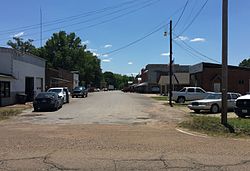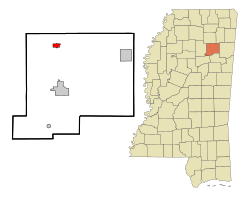New Houlka, Mississippi
| New Houlka, Mississippi | |
|---|---|
| Town | |

Walker Street
|
|
 Location of New Houlka, Mississippi |
|
| Coordinates: 34°2′11″N 89°1′12″W / 34.03639°N 89.02000°WCoordinates: 34°2′11″N 89°1′12″W / 34.03639°N 89.02000°W | |
| Country | United States |
| State | Mississippi |
| County | Chickasaw |
| Area | |
| • Total | 1.2 sq mi (3.2 km2) |
| • Land | 1.2 sq mi (3.2 km2) |
| • Water | 0.0 sq mi (0.0 km2) |
| Population (2010) | |
| • Total | 626 |
| • Density | 520/sq mi (200/km2) |
| Time zone | Central (CST) (UTC-6) |
| • Summer (DST) | CDT (UTC-5) |
| FIPS code | 28-51420 |
| GNIS feature ID | 671516 |
New Houlka is a town in Chickasaw County, Mississippi, United States. It was founded in 1904 to take advantage of a railway line of the Gulf and Ship Island Railroad. Residents moved their buildings over from the original settlement, now referred to as "Old Houlka", located to the west. The population was 626 at the 2010 census.
Started around a fur trading post prior to 1794, Old Houlka is the oldest surviving settlement in north Mississippi. In the 19th century, much of the land was developed for cotton plantations and the market town did good business.
This area was a well-established center of Chickasaw culture by the 1500s.
The first American settlers arrived in the late 1700s and established a Chickasaw Agency House at Houlka for trading with the natives. Agency representatives called the settlement "Holkey" in their earliest correspondence, which dates from 1794 after the United States gained independence from Great Britain.
Houlka was located at the crossroads of the ancient Native American pathways known as the Natchez Trace and the Gaines Trace.
In 1805, Silas Dinsmoor hosted a ball at the Agency House. Attending were future U.S. Representative John McKee and former U.S. Vice-President Aaron Burr. A post office was established in 1826. The cultivation and processing of cotton became the basis of the economy, and African slaves were brought to the region through the domestic slave trade to serve as laborers. The production of cotton brought some wealth to white planters.
During the Civil War, Confederate forces led by General Samuel J. Gholson clashed with Federal troops at a swamp-crossing near Houlka.
Houlka was incorporated in 1884. Houlka High School was founded in 1890 "to establish a permanent and high grade institution for the education of white students of both sexes". The Legislature also prohibited sales of "intoxicating liquors" within 4 mi (6.4 km) of the school. That year the Mississippi legislature, dominated by white Democrats, passed a new constitution that effectively disenfranchised most blacks, a status that the state maintained well into the 1960s to exclude them from the state's political system.
...
Wikipedia
